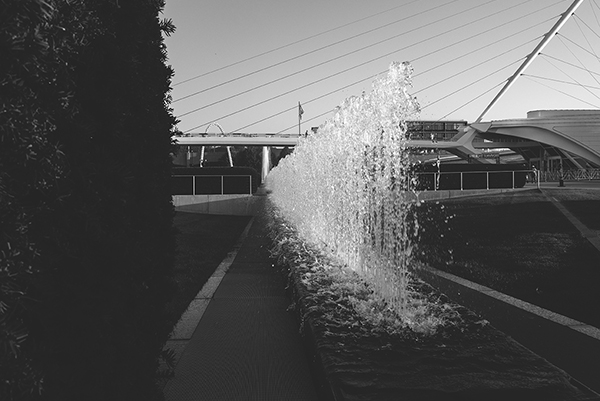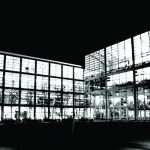“The Landscape Architecture Legacy of Dan Kiley” exhibition curated by Mo Zell, Associate Dean and Associate Professor, School of Architecture and Urban Planning, University of Wisconsin-Milwaukee, Milwaukee, WI.
Time and Place
Date: November 27, 2017 – January 12, 2018
Location: School of Architecture and Urban Planning Gallery (AUP126)
Exhibition Summary
Dan Kiley (1912–2004) worked with some of the nation’s most significant architects, such as Eero Saarinen, Louis Kahn, and I.M. Pei, to create internationally acknowledged Modernist icons. His design legacy is substantial, influential, and, like much of our Modernist designed landscape legacy, ephemeral. The exhibition is meant to honor Kiley and his legacy while calling attention to the need for informed and effective stewardship of his work and, by extension, Modernist landscape design.
The exhibition features dozens of newly created photographs by noted artists, including Milwaukee-based Tom Bamberger (former photography curator at the Milwaukee Museum of Art), Marion Brenner, Todd Eberle, Millicent Harvey, and Alan Ward. The photographs document the current state of 27 of Kiley’s more than 1,000 designs. Highlighted Kiley works include: the Cudahy Gardens at the Milwaukee Museum of Art; the Miller House and Garden, Columbus, IN; the Art Institute of Chicago’s South Garden, Chicago, IL; the Jefferson National Expansion Memorial (the grounds of “The Arch”), St. Louis, MO; and one of his final residential projects, Patterns, a garden for Gov. & Mrs. Pierre S. “Pete” du Pont IV, Wilmington, DE. A companion 72-page gallery guide includes exhibition images, brief site descriptions and plans, and excerpts from recently gathered personal recollections from Kiley’s colleagues (a recently restored site, the National Gallery of Art’s East Building, is included in the catalogue, but not the exhibition). A complementary exhibition website features additional photography and details about each site, recollections from Kiley’s friends and colleagues, along with a rating of each public site’s condition.
The following is a complete list of sites and photographers:
• Agnes R. Katz Plaza, Pittsburgh, PA, photography by Richard A. Stoner;
• Art Institute of Chicago, South Garden, Chicago, IL, photography by Tom Harris;
• Banneker Park (originally Tenth Street Overlook), Washington, D.C., photography by Frank Hallam Day;
• Concordia Theological Seminary, Fort Wayne, IN, photography by Jeffrey A. Wolin;
• Cudahy Gardens, Milwaukee Art Museum, Milwaukee, WI, photography by Tom Bamberger;
• Cummins Inc. Irwin Office Building (originally Irwin Union Bank and Trust Company), Columbus, IN, photography by Matthew Carbone;
• Currier Farm, Danby, VT, photography by Peter Vanderwarker;
• Dallas Museum of Art, Dallas, TX, photography by Alan Ward;
• Donald J. Hall Sculpture Park, The Nelson-Atkins Museum of Art, Kansas City, MO, photography by Gwen Walstrand;
• East Farm (Kiley Home and Office), Charlotte, VT, photography by Aaron Kiley;
• Ford Foundation, New York, NY, photography by David Leventi;
• Fountain Place (originally Allied Plaza), Dallas, TX, photography by Alan Ward;
• Hamilton Garden, Columbus, IN, photography by Millicent Harvey;
• Jefferson National Expansion Memorial, St Louis, MO, photography by David Johnson;
• John F. Kennedy Library, Boston, MA, photography by Alan Ward;
• Kenjockety (Shapiro Phelan Residence), Westport, NY, photography by Todd Eberle;
• Kiley Garden (originally NationsBank Plaza), Tampa, FL, photography by Maria Bevilacqua and Frederick Pirone;
• Kimmel Residence, Salisbury, CT, photography by Neil Landino, Jr.;
• Kusko Residence, Williamstown, MA, photography by Paul Warchol;
• L’Esplanade du Général de Gaulle, La Défense, Paris, France, photography by David Bacher;
• Miller House and Garden, Columbus, IN, photography by Millicent Harvey;
• Milton Lee Olive Park (originally Central District Filtration Plant), Chicago, IL, photography by Aaron Kiley;
• National Gallery of Art, East Building, Washington, D.C., photography by Lynn Silverman (catalogue only);
• North Christian Church, Columbus, IN, photography by Matthew Carbone;
• Oakland Museum of California, Oakland, CA, photography by Marion Brenner;
• Patterns (du Pont Residence), Wilmington, DE, photography by Roger Foley;
• Rockefeller University, New York, NY, photography by Benjamin Dimmitt;
• United States Air Force Academy, Colorado Springs, CO, photography by Brian K. Thomson.
This exhibition is meant to prompt questions and discussions about responsible stewardship, which is central to TCLF’s mission. While some Kiley designs are dying quiet deaths, others are extremely well maintained or require modest attention to once again achieve their brilliance. What the exhibition cannot illustrate are Kiley designs that have been lost or severely altered, such as Lincoln Center in New York, NY, and Dulles Airport, outside Washington, D.C., which architect Jacquelin Robertson says was “in some ways the most lyrical piece of large-scale landscaping that I know of in this country.”
“When the 100th anniversary of Kiley’s birth in 2012 came and went–and nothing happened–The Cultural Landscape Foundation decided to mount a tribute to this great Modernist landscape architect,” said TCLF Founder and President, Charles A. Birnbaum. “This exhibition and gallery guide are an introduction to Kiley’s life and work, not an exhaustive survey–that would take far longer than the eleven months in which this project was organized,” said Birnbaum. “By design, the catalogue entries, which present Kiley’s projects chronologically, provide a brief history and documentation of each site (and corresponding site plan), along with excerpts from recollections recently gathered from Kiley’s colleagues, including Gary Hilderbrand, Elizabeth K. Meyer, Cornelia Hahn Oberlander, Kevin Roche, Michael van Valkenburgh, Charles Waldheim, Peter Ker Walker, and Harry Wolf– lengthier entries including the complete text of the recollections are available on TCLF’s Web site.” The exhibition debuted at the Boston Architectural College on November 14, 2103, and has been hosted at the National Building Museum in Washington, D.C., the Chicago Architecture Foundation, the New York Center for Architecture, and eleven other venues to date.
Associate Dean Mo Zell of the University of Wisconsin-Milwaukee School of Architecture and Urban Planning states: “The work of Dan Kiley reminds us of the importance of the symbiotic relationship between building and the site in which it is situated. At the heart of both of these design endeavors, architecture and landscape architecture, is a rigorous intellectual pursuit with the goal of making great spaces. We are fortunate that Milwaukee boasts two of Kiley’s landscapes – the Cudahy Gardens at the Milwaukee Art Museum and the Horse Chestnut Grove outside the Marcus Center of Performing Arts in the heart of downtown. This exhibition gives us an opportunity to reinforce the alliance of these two disciplines and to have conversations that broaden the greater design discourse.”
Generous support has been provided by more than 100 organizations and individuals, including Presenting Sponsors, The Davey Tree Expert Company and Victor Stanley, Inc.; Media Partner, Landscape Architecture Magazine; Annual Partner, the American Society of Landscape Architects (ASLA); and The Hubbard Educational Foundation. Local sponsors include the Department of Planning and Landscape Architecture, University of Wisconsin-Madison; Milwaukee Downtown, BID 21; Margarete Harvey, ASLA; and the Wisconsin Chapter of ASLA.
The Cultural Landscape Foundation (TCLF) is a 501(c)(3) non-profit founded in 1998 to connect people to places. TCLF educates and engages the public to make our shared landscape heritage more visible, identify its value, and empower its stewards. Through its website, publishing, lectures, and other events, TCLF broadens support and understanding for cultural landscapes.
For more information about this exhibition, contact AUP Gallery Curator Kyle Reynolds.
Need Parking?
Please checkout Visiting the UW-Milwaukee Campus for transit and non–motorized options and parking.
Need Directions?
Get directions to The School of Architecture and Urban Planning building at the University of Wisconsin-Milwaukee is located at 2131 East Hartford Avenue, Milwaukee, Wisconsin.
Questions, comments?
All exhibitions are free and open to the public.
The exhibition is free and open and on displayed in the Architecture and Urban Planning Gallery in AUP 126 on weekdays, not including holidays, Monday – Friday, 7a.m. to 3p.m., and by appointment/special request, unless otherwise noted.
Additional information about the exhibition can be found by contacting the main reception at (414) 229-4014, and by emailing any inquiries to Mo Zell, Associate Dean and Associate Professor


